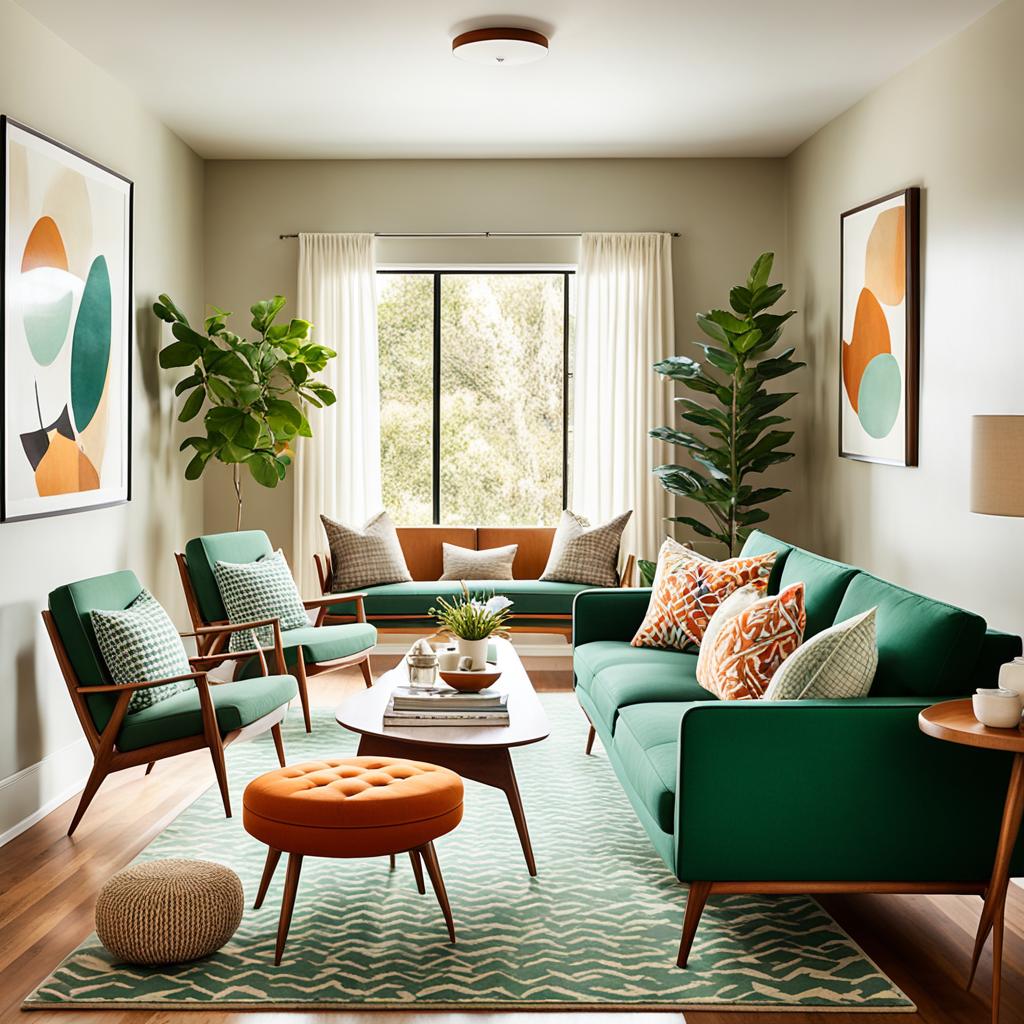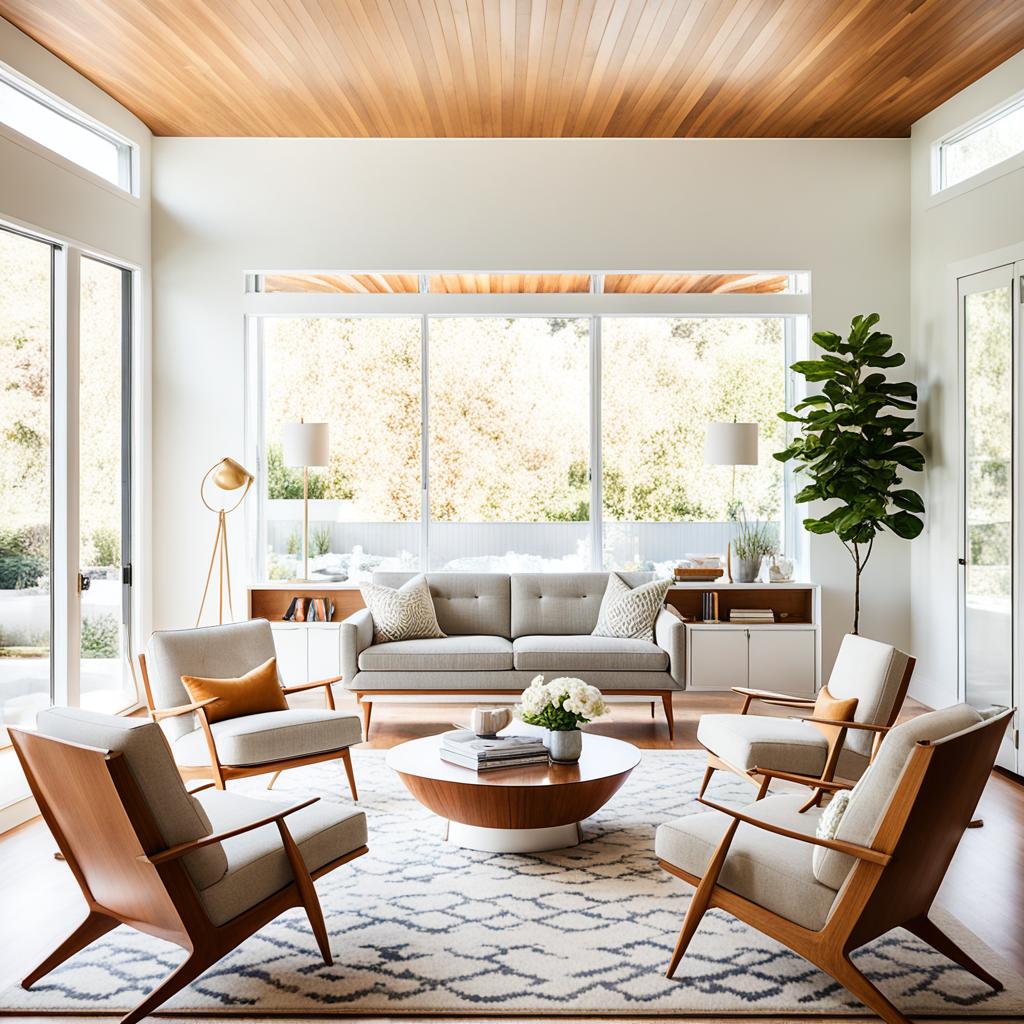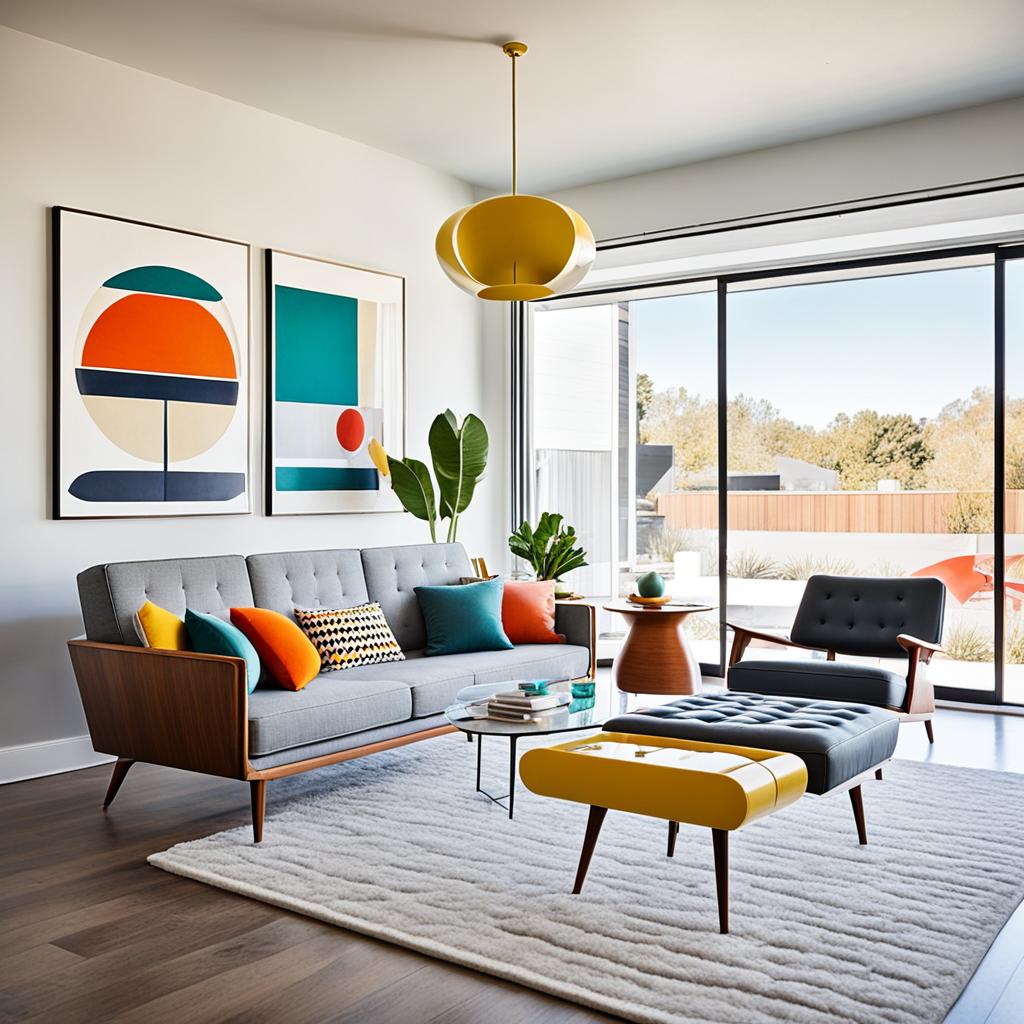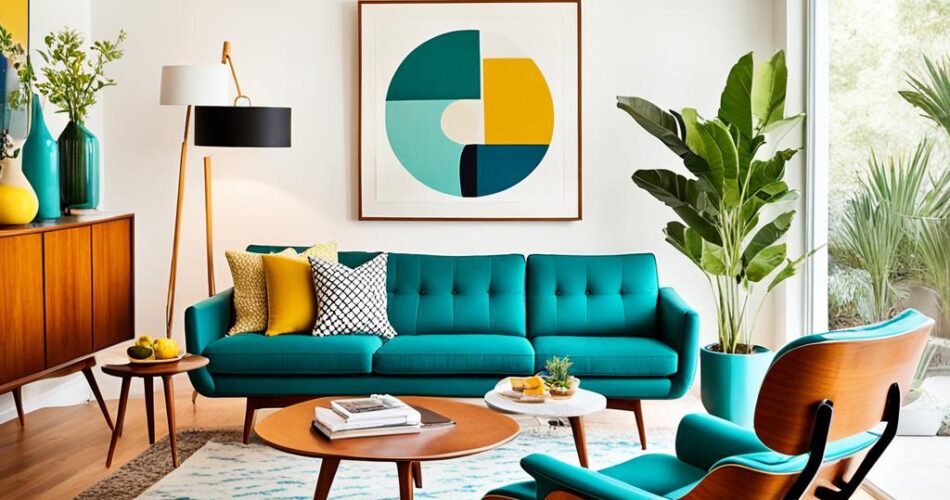Mid-century modern interior design originated in the mid-20th century. This style captivated designers and homeowners with its retro decor and minimalist furniture. It juxtaposed organic shapes with sleek lines, incorporating elements like tapered legs, geometric patterns, and vintage lighting.
Natural materials like wood and leather were commonly used. Pops of vibrant colors and retro accents created a harmonious blend. Minimalist furnishings and bold colors were seamlessly combined.
Key Takeaways
- Mid-century modern design features clean lines, organic shapes, and minimalist furnishings.
- Natural materials like wood and leather are commonly used, along with vibrant colors and retro accents.
- Tapered legs, geometric patterns, and vintage lighting are signature elements of this style.
- Open floor plans and natural lighting are hallmarks of mid-century modern interiors.
- Blending vintage and contemporary pieces creates a timeless and eclectic charm.
Mid-Century Modern Interior Design: A Timeless Style
The mid-century modern style emerged after World War II. It drew inspiration from bold, innovative art movements. It embodied optimism and progress in post-war America.
It ushered in an era of minimalist aesthetics and clean lines.
Origins and Influences
Mid-century modern interior design originated in the mid-1940s. Designers sought a break from ornate, decorative styles. They embraced functional, streamlined approaches driven by principles.
Defining Characteristics
This design blends organic shapes and minimal ornamentation. It uses natural materials like teak and rosewood. It celebrates simplicity and functionality with sleek profiles.
Furniture features tapered legs and atomic patterns. Vintage-inspired accents and retro styling add nostalgia.
Iconic Designers and Pieces
Iconic designers include Charles and Ray Eames, Isamu Noguchi, and George Nelson. Their pioneering designs are timeless classics.
The Eames Lounge Chair, Noguchi Table, and Nelson Ball Clock integrate form and function.
Globally, mid-century modern design captivates with timeless appeal. It inspires minimalist living spaces and mid-mod decor.
Clean Lines and Organic Shapes
Mid-century modern furniture combines minimalist interiors with vintage decor.
It blends modernist architecture and atomic age aesthetics.
Its clean lines and organic shapes prioritize functional design.
Minimalist Furniture
Mid-century furniture has a minimalist aesthetic with tapered legs.
Low profiles and sleek silhouettes define these pieces.

Functional Design
Functional design is core to mid-century modern style.
Every element was crafted with purpose in mind.
Pieces integrated seamlessly into 1950s living spaces.
Geometric Patterns
Atomic age aesthetics inspired geometric patterns and shapes.
Iconic chairs like Eames celebrated sculptural biomorphic forms.
Earth tones enhanced the harmony of form and function.
Natural Materials and Warm Tones
Mid-century modern interiors blend natural materials and warm tones, creating inviting spaces. Vintage modern decor celebrates organic elements and seamless lines. Mid-century modern furniture movement defines minimalist principles.
Wood Accents
Rich wood accents lend warmth to mid-century modern design. Teak, rosewood, walnut grace artisan craftsmanship furniture pieces and accent walls. Natural wood grains and tones complement danish modern style.

Leather and Textile Textures
Layering texture achieves an inviting ambiance in mad men style interiors. Supple leather upholstery adds warmth and sophistication. Textured fabrics like wool and linen introduce depth.
Natural materials balance sleek lines and bauhaus influence, fusing organic modernism and atomic age aesthetic. Vintage furnishings, from iconic chairs to sputnik lighting, celebrate innovative spirit.
This integration results in timeless, personal interiors reflecting the design movement’s enduring appeal.
Pops of Color and Playful Accents
Mid-century modern interiors embrace warm neutrals and natural materials. Splashes of color and retro décor elements capture the era’s exuberance. Influenced by Scandinavian design influences, these spaces balance vibrant hues and graphic patterns.
Teak wood furniture grounds the space. Statement pieces like Sputnik chandeliers and patterned wallpapers complement it. These retro aesthetics infuse spaces with personality, reflecting mid-20th century optimism.

Funky colors like mustard yellow, olive green, and oranges were embraced. These added playful accents to minimalist interiors. Paired with industrial accents and open floor plans, these hues created dynamic, inviting environments.
| Color | Description | Pairings |
|---|---|---|
| Mustard Yellow | Bold and warm, evoking retro vibes | Teak wood, gray, navy blue |
| Olive Green | Earthy and sophisticated | Teak wood, white, brown |
| Orange | Vibrant and energetic | Teak wood, blue, white |
Graphic patterns on textiles and funky colors on accent walls embraced playfulness. Mid-century modern design created stylish, character-filled spaces through experimentation.
Maximizing Natural Light
Mid-century modern design prioritized maximizing natural lighting in interior spaces. This was achieved through architectural elements and thoughtful design choices.
Open floor plans eliminated unnecessary walls, allowing sunlight to penetrate living areas. The spacious layouts fostered a bright, airy ambiance.
Seamless flow between rooms created expansiveness and minimalism, complementing functional simplicity.
Strategic Window Placement
Large, floor-to-ceiling windows maximized natural light exposure. Indoor and outdoor spaces blurred boundaries.
This approach illuminated interiors, providing picturesque views. Nature invited into homes celebrated vintage-inspired aesthetics.

Mirrors and Reflective Surfaces
Strategically placed mirrors bounced light, creating an illusion of expanded dimensions. Polished metals like chrome and brass contributed to this light-reflecting effect.
Open floor plans, strategic windows, and reflective surfaces balanced natural light and spaciousness. Functional elegance combined with wood accents, geometric patterns, and statement furniture.
Interiors celebrated space age aesthetics while embracing retro home decor’s warmth.
Mixing Vintage and Contemporary
Achieving a harmonious blend is mid-century modern interior design’s epitome. This approach creates timeless charm. By juxtaposing retro furnishings with contemporary pieces, you craft a space celebrating mid-mod design while keeping it fresh.
Retro Furnishings
The heart lies in vintage style furnishings. Iconic pieces like Eames lounge chairs, teak sideboards, and atomic lamps instantly transport you. These timeless classics add nostalgia and anchor the aesthetic.

Modern Twist
To prevent a time capsule feel, incorporate modern elements. Pair retro style furnishings with sleek, contemporary minimalist design pieces. This unexpected contrast keeps the space vibrant and current.
Eclectic Charm
The beauty lies in seamlessly blending old and new. Earthy color palettes, natural wood accents, and indoor plants add warmth, reflecting organic material appreciation. This fusion results in undeniable eclectic charm.
Mixing vintage interiors with contemporary pieces creates a captivating, unique living space. It pays homage to the past while remaining rooted in the present.
Achieving a Mid-Century Modern Interior
Creating a mid-century modern interior artfully blends iconic designers, functional elegance, and timeless appeal. The key lies in curating furniture, color palettes, and accessories that embody that era’s distinctive aesthetic.
Furniture Selection
Invest in pieces from renowned mid-century designers like Charles and Ray Eames, George Nelson, and Isamu Noguchi. Their iconic designs, such as the Eames Lounge Chair, Nelson Ball Clock, and Noguchi Coffee Table, offer unparalleled functionality and vintage charm.
Color Palette
A harmonious mid-century color palette revolves around warm neutrals, earthy tones, and strategic pops of vibrant hues. Shades like mustard yellow, olive green, and orange create an inviting atmosphere. Geometric shapes and architectural elements add visual interest.

Lighting and Accessories
Vintage-inspired lighting and funky furniture capture the mid-mod spirit. Sculptural lamps, Sputnik chandeliers, and retro accents like starburst clocks or atomic-age ceramics infuse your space with a playful, nostalgic vibe.
Wood furniture, with its warm tones and organic textures, beautifully complements the overall aesthetic.
| Furniture | Colors | Accents |
|---|---|---|
| Eames Lounge Chair Nelson Marshmallow Sofa Noguchi Coffee Table |
Mustard Yellow Olive Green Burnt Orange Walnut Brown |
Sputnik Chandelier Starburst Clock Atomic-Age Ceramics Geometric Patterns |
By thoughtfully selecting iconic furniture pieces, embracing earthy color palettes, and incorporating vintage-inspired accents, you create a mid-century modern interior exuding functional elegance and timeless appeal.
Versatility and Adaptability
The timeless mid-century modern design attracts with versatility and adaptability. This iconic style gracefully integrates into various living and working environments. Designers and homeowners admire it.
Living rooms with tapered leg sofas and kidney-shaped tables exude sophistication. Workspaces with wood accent walls feel warm. Mid-mod elements elevate any space.
Residential Spaces
In homes, mid-century modern creates inviting, stylish living areas. Vintage elements like Eames chairs blend with contemporary pieces. The aesthetic bridges past and present harmoniously.
Warm neutrals and natural wood tones foster coziness. Modernist decor and minimalist living promote functional simplicity.
Commercial Settings
Mid-century modern’s versatility extends to commercial spaces. In offices and retail, functional simplicity and natural wood tones create productivity and invitation.
Scandinavian aesthetics like clean lines contribute calm sophistication. Pops of color and 1950s style furniture add retro charm.
| Design Element | Residential Spaces | Commercial Settings |
|---|---|---|
| Color Palette | Warm neutrals, natural wood tones | Scandinavian aesthetics, pops of color |
| Furniture | Tapered leg sofas, kidney-shaped tables | 1950s style furniture, modernist decor |
| Accents | Vintage elements, minimalist living | Wood accent walls, functional simplicity |
From sleek hospitality to eclectic retail, mid-century modern’s enduring appeal adapts to diverse needs and styles in both residential and commercial settings.
Conclusion
Mid-century modern interior design captivates with its atomic age charm. Iconic furniture designs blend retro vibes with modern sensibilities. Warm tones and nature-inspired elements create inviting spaces.
Scandinavian furniture’s clean lines coexist with vintage accents. Vibrant color palettes enhance these functional, stylish spaces. Mid-mod design draws from 1950s atomic era style.
Vintage-inspired pieces merge with contemporary palettes adeptly. This nostalgic yet modern aesthetic resonates widely. Mid-century decor continues gaining momentum through versatile retro interiors.
Iconic designs like Eames chairs and Noguchi tables exemplify this trend. Incorporating sustainable materials, mid-mod interiors achieve functional elegance. The vintage aesthetic charms those seeking timeless style.
